
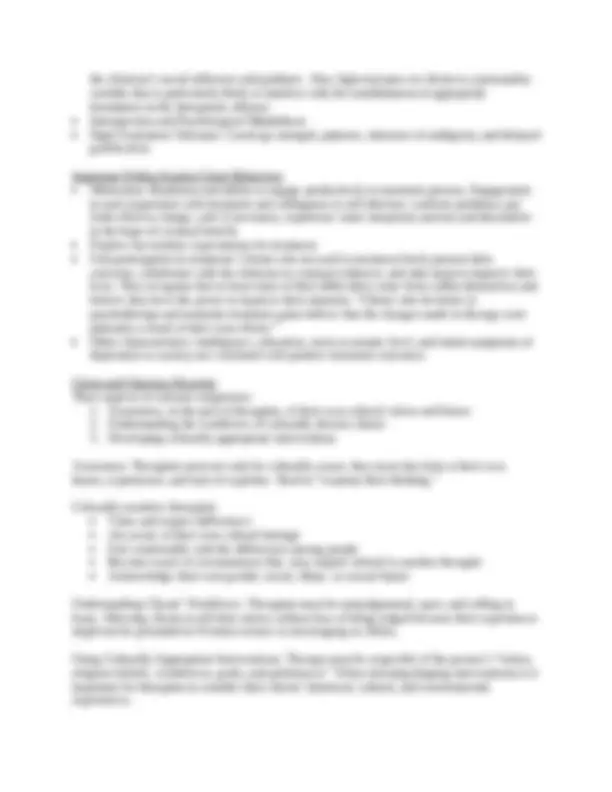
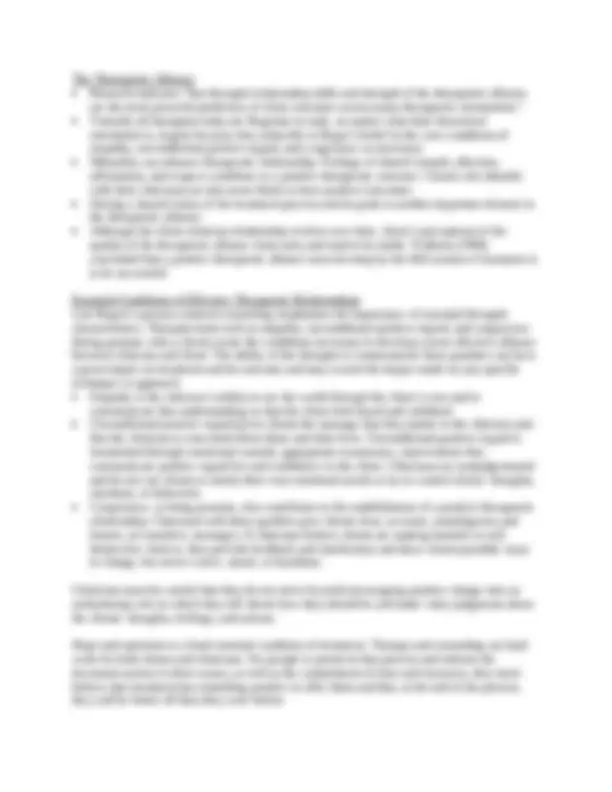
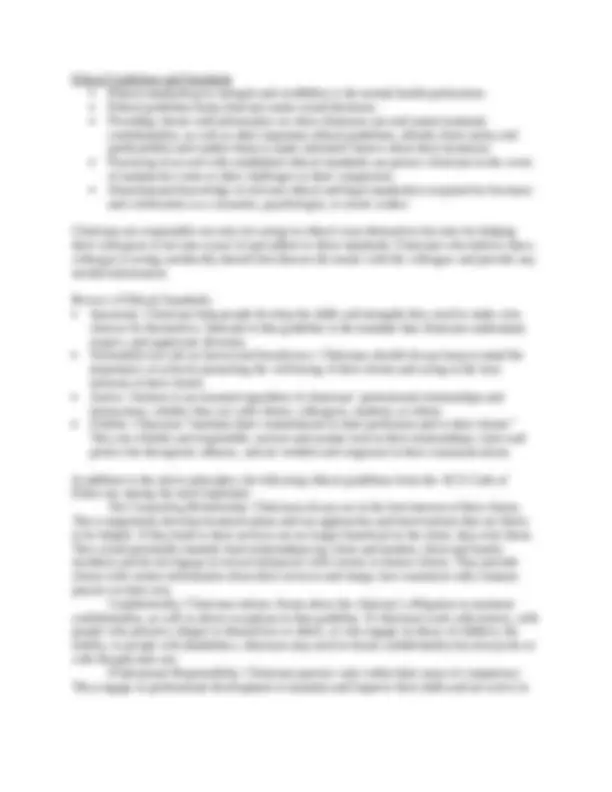
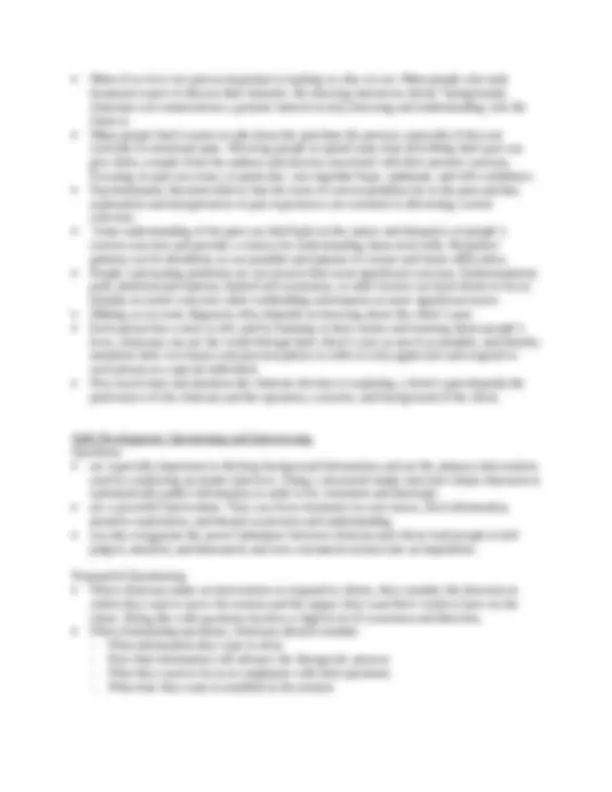
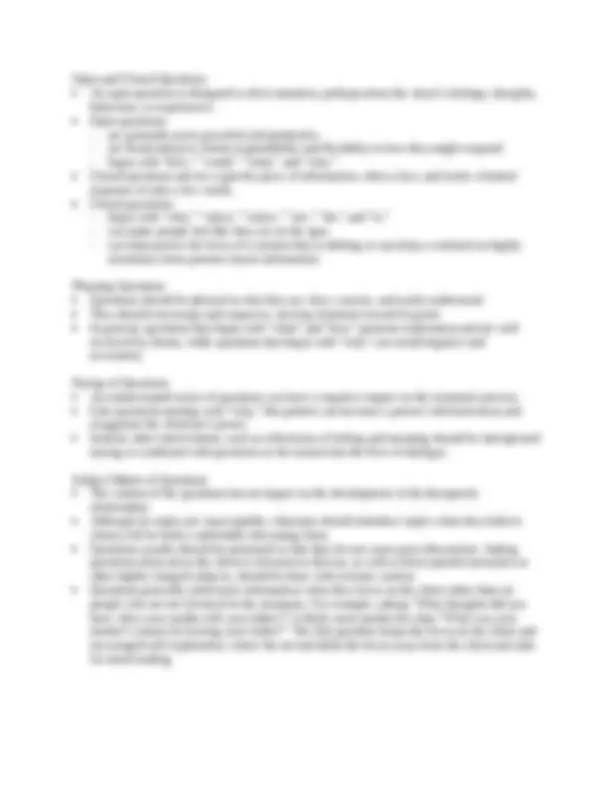
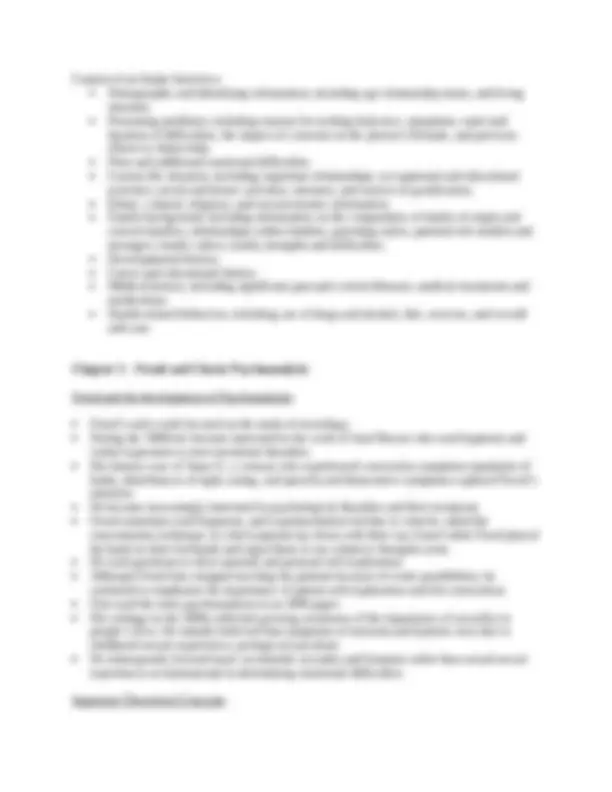
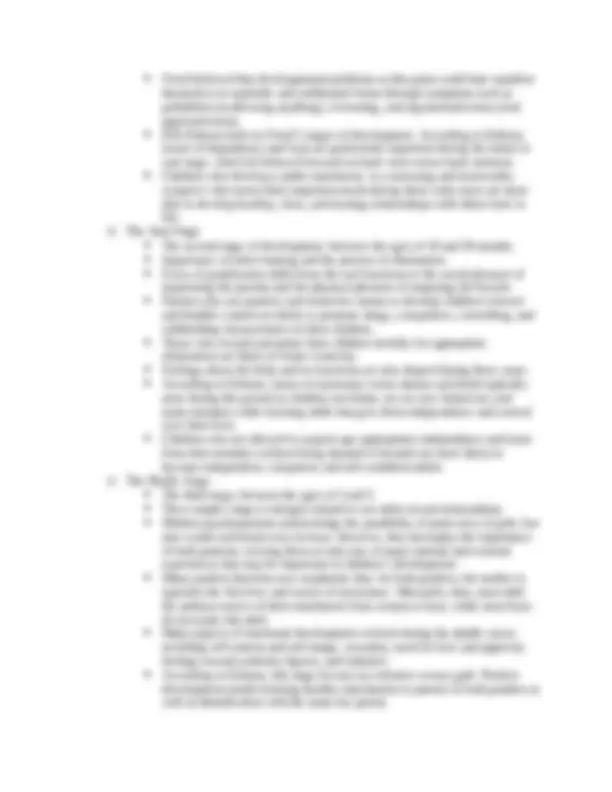

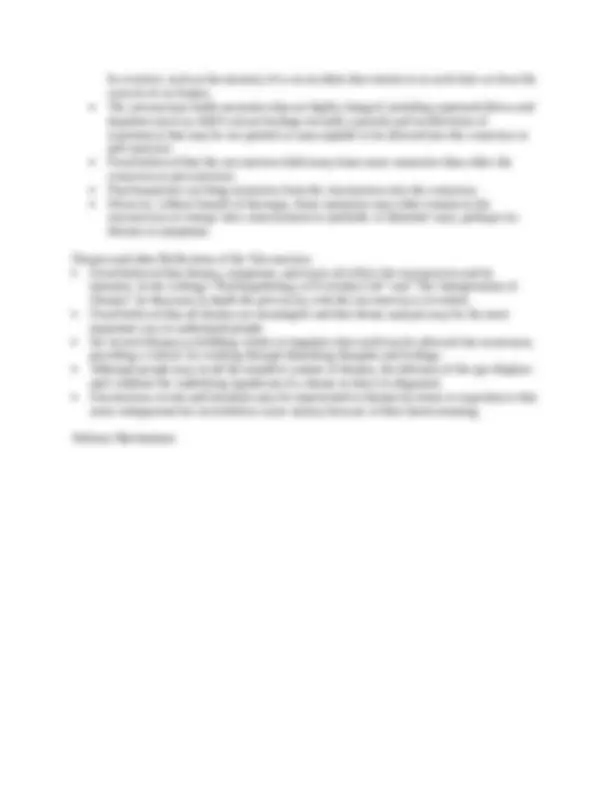


Study with the several resources on Docsity

Earn points by helping other students or get them with a premium plan


Prepare for your exams
Study with the several resources on Docsity

Earn points to download
Earn points by helping other students or get them with a premium plan
Community
Ask the community for help and clear up your study doubts
Discover the best universities in your country according to Docsity users
Free resources
Download our free guides on studying techniques, anxiety management strategies, and thesis advice from Docsity tutors
Notes from graduate level course on theories of counseling
Typology: Lecture notes
1 / 15

This page cannot be seen from the preview
Don't miss anything!










Chapter 1 Development of Theories of Counseling & Psychotherapy First Force: Psychoanalysis/Psychodynamic Psychotherapy Freud Past experiences as the source of people’s emotional difficulties in the present. Emphasizing unconscious processes and long-term treatment. Second Force: Cognitive & Behavioral Theories and Interventions BF Skinner, Albert Ellis, Aaron Beck, William Glasser, D. Meichenbaum, etc. Behavioral treatment approaches (70s) have been integrated with cognitive approaches (80s) leading to Cognitive-Behavioral approaches in the 1990s Emphasize the influence of thoughts and actions on emotions Interventions generally focus on the present and seek to minimize dysfunctional cognitions and behaviors while replacing them with more helpful and positive thoughts and actions. Third Force: Existential-Humanistic Psychotherapy Carl Rogers, Fritz Perls, Victor Frankl, etc. Emphasizes the importance of emotions and sensations and of people taking charge of and finding meaning in their lives. Drew attentions to the importance of the therapeutic alliance. Fourth Force: Integrative Elements of all previous three forces are integrated into a comprehensive and holistic effort to understand people as fully as possible. Includes new approaches such as narrative therapy, positive psychology, and mindfulness. Treatment is Effective Martin Seligman, in 1995, conducted “the most extensive study of psychotherapy on record.” Found that 87% of people who reported feeling “very poor” and 92% of people who said they felt “fairly poor” before therapy showed clear improvement by the end of treatment. Improvement was long-lasting and reflected in changes in presenting concerns as well as improivement in occupational, social, and personal domains. Long-term treatment was generally superior to short-term treatment. Common “Ingredients” that Promote Change A therapeutic relationship characterized by collaboration, trust, mutual investment in the therapeutic process, shared respect, genuineness, positive emotional feelings, and a holistic understanding of clients and their backgrounds and environments. A safe, supportive, and healing context. Goals and a sense of direction, preferably explicit, but sometimes implicit.
A shared understanding about the nature of the problems and concerns to be addressed in treatment and the change processes that will be used to resolve them. Therapeutic learning, typically including feedback and corrective experiences. Encouragement of self-awareness and insight. Improvement in clients’ ability to identify, express constructively, and modify their emotions and feelings. Improvement in clients’ ability to assess and change dysfunctional behaviors as well as acquire new and more effective behaviors that promote coping, impulse control, sounds relationships, and good emotional and physical health. Understanding Mental Health Witmer and Sweeney (1992) advanced a holistic model for optimal health and functioning that delineates five important aspects of peoples’ lives: Spirituality – Values, beliefs, ethics, purpose, direction, optimism, inner peace. Self-Regulation – Sense of worth, mastery of one’s own life, spontaneity, emotional responsiveness, sense of humor, creativity, awareness of reality, psysical health. Work – Paid employment, volunteer experiences, child rearing, homemaking, and education that provide psychological, social, and other rewards. Friendship – Positive interpersonal relationships and social support that provide rewarding activities and interactions. Love – Intimate, trusting, sharing, and cooperative long-term relationships. These five areas serve as a map of healthy functioning. They also delineate areas for assessment. Deficits in any of these five areas are likely to impair functioning, cause distress, require help, and be an appropriate focus for treatment. Remember the pie chart: 40% Extra-therapeutic Factors 30% Client-Therapist Relationship 15% Client’s Hope and Expectation of Positive Change 15% Specific Therapeutic Techniques Characteristics of Successful Clients Maturity: Reasonably well-organized lives, responsible, knowledgeable about the world. Capacity for Relationships: Interpersonal qualities such as good communication skills, an ability to invest energy and caring in personal relationships, and the capacity to form stable and close relationships are important client strengths. The client’s attachment style moderates the relationship between counseling experience and working alliance. Those clients who can form positive relationships and have a need for intimacy, trust in others, and fear of abandonment. Ability to Establish Appropriate Interpersonal Boundaries: People who have good self- esteem, and a sense of control over their lives, are likely to establish appropriate boundaries both within and outside the therapeutic relationship. On the other hand, people who have inordinate needs for affiliation may seek an overinvolved and dependant relationship with the clinician. And people who have extreme needs for separateness and independence may reject
The Therapeutic Alliance Research indicates “that therapist relationship skills and strength of the therapeutic alliance are the most powerful predictors of client outcomes across many therapeutic orientations.” Virtually all therapists today are Rogerian in style, no matter what their theoretical orientation is, largely because they subscribe to Roger’s belief in the core conditions of empathy, unconditional positive regard, and congruence as necessary. Mutuality can enhance therapeutic relationship. Feelings of shared warmth, affection, affirmation, and respect contribute to a positive therapeutic outcome. Clients who identify with their clinicians are also more likely to have positive outcomes. Having a shared vision of the treatment process and its goals is another important element in the therapeutic alliance. Although the client-clinician relationship evolves over time, client’s perceptions of the quality of the therapeutic alliance form early and tend to be stable. Walborn (1996) concluded that a positive therapeutic alliance must develop by the fifth session if treatment is to be successful. Essential Conditions of Effective Therapeutic Relationships Carl Rogers’s person-centered counseling emphasizes the importance of essential therapist characteristics. Therapist traits such as empathy, unconditional positive regard, and congruence (being genuine with a client) create the conditions necessary to develop a more effective alliance between clinician and client. The ability of the therapist to communicate these qualities can have a great impact on treatment and its outcome and may exceed the impact made by any specific technique or approach. Empathy is the clinician’s ability to see the world through the client’s eyes and to communicate that understanding so that the client feels heard and validated. Unconditional positive regard gives clients the message that they matter to the clinician and that the clinician is concerned about them and their lives. Unconditional positive regard is transmitted through emotional warmth, appropriate reassurance, interventions that communicate positive regard for and confidence in the client. Clinicians are nonjudgemental and do not use clients to satisfy their own emotional needs or try to control clients’ thoughts, emotions, or behaviors. Congruence , or being genuine, also contributes to the establishment of a positive therapeutic relationship. Clinicians with these qualities give clients clear, accurate, unambiguous and honest, yet sensitive, messages. If clinicians believe clients are making harmful or self- destructive choices, they provide feedback and clarification and show clients possible ways to change, but never coerce, attack, or humiliate. Clinicians must be careful that they do not move beyond encouraging positive change into an authoritarian role in which they tell clients how they should be and make value judgments about the clients’ thoughts, feelings, and actions. Hope and optimism is a final essential condition of treatment. Therapy and counseling are hard work for both clients and clinicians. For people to persist in that process and tolerate the increased anxiety it often causes, as well as the commitment of time and resources, they must believe that treatment has something positive to offer them and that, at the end of the process, they will be better off than they were before.
Ethical Guidelines and Standards Ethical standards give strength and credibility to the mental health professions. Ethical guidelines help clinicians make sound decisions. Providing clients with information on when clinicians can and cannot maintain confidentiality, as well as other important ethical guidelines, affords client safety and predictability and enables them to make informed choices about their treatment. Practicing in accord with established ethical standards can protect clinicians in the event of malpractice suits or other challenges to their competence. Demonstrated knowledge of relevant ethical and legal standards is required for licensure and certification as a counselor, psychologist, or social worker. Clinicians are responsible not only for acting in ethical ways themselves but also for helping their colleagues to become aware of and adhere to these standards. Clinicians who believe that a colleague is acting unethically should first discuss the matter with the colleague and provide any needed information. Review of Ethical Standards: Autonomy : Clinicians help people develop the skills and strengths they need to make wise choices for themselves. Inherant in this guideline is the mandate that clinicians understand, respect, and appreciate diversity. Nonmaleficence (do no harm) and beneficence : Clinicians should always keep in mind the importance of actively promoting the well-being of their clients and acting in the best interests of their clients. Justice : Fairness is an essential ingredient of clinicians’ professional relationships and interactions, whether they are with clients, colleagues, students, or others. Fidelity : Clinicians “maintain their commitments to their profession and to their clients.” They are reliable and responsible, nurture and sustain trust in their relationships, value and protect the therapeutic alliance, and are truthful and congruent in their communications. In addition to the above principles, the following ethical guidelines from the ACA Code of Ethics are among the most important: The Counseling Relationship : Clinicians always act in the best interest of their clients. They competently develop treatment plans and use approaches and interventions that are likely to be helpful. If they believe their services are no longer beneficial to the client, they refer them. They avoid potentially harmful dual relationships (eg client and student, client and family member) and do not engage in sexual intimacies with current or former clients. They provide clients with written information about their services and charge fees consistent with common practice in their area. Confidentiality : Clinicians inform clients about the clinician’s obligation to maintain confidentiality, as well as about exceptions to that guideline. If clinicians work with minors, with people who present a danger to themselves or others, or who engage in abuse of children, the elderly, or people with disabilities, clinicians may need to break confidentiality but always do so with thought and care. Professional Responsibility : Clinicians practice only within their areas of competence. They engage in professional development to maintain and improve their skills and are active in
1. Umm-hmmm. A supportive murmur from the clinician accompanied by a nod of the head and an attentive posture. If clients are talking easily about themselves and using their time productively, thus may be all they need to continue that process 2. Repetition of a word. Here, the clinician repeats or underscores a client’s spoken word or phrase. This narrows the client’s attention and generally encourages the client to elaborate further. Although this intervention is very brief, it can have a considerable impact on the direction of treatment. 3. How so? Although this brief phrase is really a question, it functions like a minimal encourager in that is prompts the client to hone in on a particular point and explore it in greater depth. Restatement: Restatement involves repeating or underscoring a longer phrase or sentence that the client has spoken. It can be thought of as an expanded version of a minimal encourager and serves the same purpose: focusing the client’s attention and promoting self-expression without adding to, changing, or interpreting the client’s words. Paraphrase: In a paraphrase, clinicians feed back to clients the essence of what they have said. Although clinicians use different words from those of the client, they not seek to interpret, analyze, or add depth to a client’s statement. Rather, they simply give clients an opportunity to hear what they have said. Paraphrases let clients know that the clinician is listening and understanding them, and encourages clients to keep talking. Summarization: A summarization pulls together and synthesizes a group of client statements. They are useful for focusing a session, bringing closure to a topic, wrapping up a session, and helping clients reflect on what they have said. Like paraphrases, summarizations are nor interpretive or analytical but simply feed back in a concise and coherent way what clients have said. Chapter 2 – Overview of Background-Focused Treatment Systems All of our experiences have shaped and continue to shape us. Most clinicians agree that we cannot fully understand our clients and their concerns unless we learn about their backgrounds and contexts. However, clinicians disagree on the amount of time they spend exploring clients’ histories, on the importance of past experiences in determining present functioning, and on the ways clinicians should focus on those past experiences in relieving present concerns and promoting mental health. Importance of Past Experiences in Treatment Incorporating the discussion and processing of past experiences into treatment can greatly enhance its impact.
Most of us view our past as important to making us who we are. Most people who seek treatment expect to discuss their histories. By showing interest in clients’ backgrounds, clinicians can communicate a genuine interest in truly knowing and understanding who the client is. Many people find it easier to talk about the past than the present, especially if they are currently in emotional pain. Allowing people to spend some time describing their past can give them a respite from the sadness and anxiety associated with their present concerns. Focusing on past successes, in particular, can engender hope, optimism, and self-confidence. Psychodynamic theorists believe that the roots of current problems lie in the past and that exploration and interpretation of past experiences are essential to alleviating current concerns. Some understanding of the past can shed light on the nature and dynamics of people’s current concerns and provide a context for understanding them more fully. Repetitive patterns can be identified, as can possible precipitants of current and future difficulties. People’s presenting problems are not always their most significant concerns. Embarrassment, guilt, distorted perceptions, limited self-awareness, or other factors can lead clients to focus initially on minor concerns while withholding information on more significant issues. Making an accurate diagnosis often depends on knowing about the client’s past. Each person has a story to tell, and by listening to their stories and learning about people’s lives, clinicians can see the world through their client’s eyes as much as possible, and thereby minimize their own biases and preconceptions in order to truly appreciate and respond to each person as a special individual. How much time and attention the clinician devotes to exploring a client’s past depends the preferences of the clinician and the openness, concerns, and background of the client. Skill Development: Questioning and Interviewing Questions: are especially important in eliciting background information and are the primary intervention used in conducting an intake interview. Using a structured intake interview helps clinicians to systematically gather information in order to be consistent and thorough. are a powerful intervention. They can focus treatment on core issues, elicit information, promote exploration, and deepen awareness and understanding. can also exaggerate the power imbalance between clinician and client; lead people to feel judged, attacked, and demeaned; and turn a treatment session into an inquisition. Purposeful Questioning When clinicians make an intervention or respond to clients, they consider the direction to which they want to move the session and the impact they want their words to have on the client. Doing this with questions involves a high level of awareness and direction. When formulating questions, clinicians should consider:
Content of an Intake Interview: Demographic and identifying information, including age relationship status, and living situation Presenting problems, including reasons for seeking help now, symptoms, onset and duration of difficulties, the impact of concerns on the person’s lifestyle, and previous efforts to obtain help. Prior and additional emotional difficulties. Current life situation, including important relationships, occupational and educational activities, social and leisure activities, stressors, and sources of gratification. Ethnic, cultural, religious, and socioeconomic information. Family background, including information on the composition of family of origin and current families, relationships within families, parenting styles, parental role models and messages, family values, family strengths and difficulties. Developmental history. Career and educational history. Medical history, including significant past and current illnesses, medical treatments and medications. Health-related behaviors, including use of drugs and alcohol, diet, exercise, and overall self-care. Chapter 3 – Freud and Classic Psychoanalysis Freud and the development of Psychoanalysis Freud’s early work focused on the study of neurology. During the 1880s he became interested in the work of Josef Breuer who used hypnosis and verbal expression to treat emotional disorders. His famous case of Anna O., a woman who experienced conversion symptoms (paralysis of limbs, disturbances of sight, eating, and speech) and dissociative symptoms captured Freud’s attention. He became increasingly interested in psychological disorders and their treatment. Freud sometimes used hypnosis, and experimentation led him to what he called the concentration technique, in which patients lay down with their eye closed while Freud placed his hand on their foreheads and urged them to say whatever thoughts arose. He used questions to elicit material and promote self-exploration. Although Freud later stopped touching his patients because of erotic possibilities, he continued to emphasize the importance of patient self-exploration and free association. First used the term psychoanalysis in an 1896 paper. His writings in the 1890s reflected growing awareness of the importance of sexuality in people’s lives. He initially believed that symptoms of neurosis and hysteria were due to childhood sexual experiences, perhaps sexual abuse. He subsequently focused more on infantile sexuality and fantasies rather than actual sexual experiences as instrumental in determining emotional difficulties. Important Theoretical Concepts
Human Nature Freud placed great emphasis on the influence of biology and of early childhood experiences. He believed that people go through predictable stages of psychosocial development and must struggle to find a balance between their strong sexual drives and their need to behave in socially acceptable ways. He viewed people as seeking to win love and approval by acting in ways that reflected the dictates of their families and societies. Emphasized irrational and instinctual forces in shaping people, but also believed that people can use psychotherapy and other sources of help and personal growth to gain insight, lessen the power of the unconscious, and free ourselves to make conscious and healthy choices. Understanding early development, and he pressures of the libido and the superego, and strengthening our egos can enable us to lead the sorts of lives and have the types of relationships that we desire. Personality Structure According to Freud, the personality is composed of three structures: the id (biological component), the ego (psychological component), and the superego (social component). These structures often overlap and intertwine--they are not discrete entities--although each has distinctive properties. They are separated only by artificial boundaries/constructs. o The Id: First system of the personality. Present at birth, it encompasses all of the inherited systems, including instincts, and is largely unconscious. The id derives its energy from bodily processes and is in touch with the needs and messages of the body, seeking to satisfy them when possible. The id is subjective and emotional and, in its pure form, is not moderated by the external world. (Wants what it wants when it wants it) The id (like the infant in which it originates) is intolerant of tension, pain, and discomfort and seeks to avoid them by pursuing pleasure and gratification (the pleasure principle). The id has two strategies for obtaining pleasure:
Freud believed that developmental problems at this point could later manifest themselves in symbolic and sublimated forms through symptoms such as gullability (swallowing anything), overeating, and argumentativeness (oral aggressiveness). Erik Erikson built on Freud’s stages of development. According to Erikson, issues of dependency and trust are particularly important during the initial or oral stage, which he believed focused on basic trust versus basic mistrust. Children who develop a stable attachment to a nurturing and trustworthy caregiver who meets their important needs during these early years are more able to develop healthy, close, and trusting relationships with others later in life. o The Anal Stage The second stage of development, between the ages of 18 and 36 months. Importance of toilet training and the process of elimination. Focus of gratification shifts from the oral functions to the social pleasure of impressing the parents and the physical pleasure of emptying the bowels. Parents who use punitive and restrictive means to develop children’s bowel and bladder control are likely to promote stingy, compulsive, controlling, and withholding characteristics in their children. Those who reward and praise their children lavishly for appropriate elimination are likely to foster creativity. Feelings about the body and its functions are also shaped during these years. According to Erikson, issues of autonomy versus shame and doubt typically arise during this period as children test limits, try out new behaviors, and make mistakes while learning skills that give them independence and control over their lives. Children who are allowed to acquire age-appropriate independence and learn from their mistakes without being shamed or berated are more likely to become independent, competent, and self-confident adults. o The Phallic Stage The third stage, between the ages of 3 and 5. This complex stage is strongly related to our adult sexual relationships. Modern psychoanalysts acknowledge the possibility of penis envy in girls, but also womb and breast envy in boys. However, they downplay the importance of both patterns, viewing them as only one of many internal and external experiences that may be important in children’s development. Many modern theorists now emphasize that, for both genders, the mother is typically the first love and source of nurturance. Most girls, then, must shift the primary source of their attachment from women to men, while most boys do not make this shift. Many aspects of emotional development evolved during the phallic years, including self-esteem and self-image, sexuality, need for love and approval, feelings toward authority figures, and initiative. According to Erikson, this stage focuses on initiative versus guilt. Positive development entails forming healthy attachments to parents of both genders as well as identification with the same-sex parent.
This enables children to develop feelings of competence, to make and trust their own decisions, and to take the initiative in moving forward with their lives. Those who do not resolve this stage successfully may be troubled by guilt, difficulty in intimate relationships, and a negative or confused sense of self. o The Latency Stage Ages 5 – 11 Relatively quiet period in a child’s sexual development, which is why it is called the latency period. Sexual drives become less important, while social interests increase. Emotional development focuses their ability to take on and succeed in new challenges and endeavors and to set and achieve realistic goals. Children who negotiate this stage successfully typically develop feelings of empowerment and have initiative, whereas others may develop low self- esteem. Freud’s latency period parallels Erikson’s fourth stage, industry versus inferiority , occurring between the ages of 6 and 12. Positive development during these years entails achievement of social and academic success. Children learn good work habits and become productive and able to meet new challenges. o The Genital Stage Final stage: 11 – adult Adolescents and adults solidify their personal identities, develop caring and altruistic feeling toward others, establish positive loving and sexual relationships, and progress toward successful careers. Paralleling the first part of Freud’s genital stage is Erikson’s stage of identity versus role confusion , occurring between ages 12 and 18. During the adolescent years young people develop identities and formulate self-images that will greatly influence their ability to love and work. Those who develop a clear and positive sense of themselves and their roles are more likely, according to Erikson, to find later fulfillment in both relationships and careers. Erikson’s Additional Stages: Stage 6: Ages 18 to 35. Intimacy versus isolation. Stage 7: Ages 35 to 60. Generativity versus stagnation. Stage 8: Ages 60 to death. Integrity versus despair. Levels of Consciousness According to Freud, we have three levels of consciousness: the conscious, the preconscious, and the unconscious. The conscious material in awareness, always available to us. The preconscious holds information that may not be part of current awareness but which can be readily accessed. This material may be benign, such as the memory of a person we knew years ago but did not think of until we see her again at the grocery store; or it may